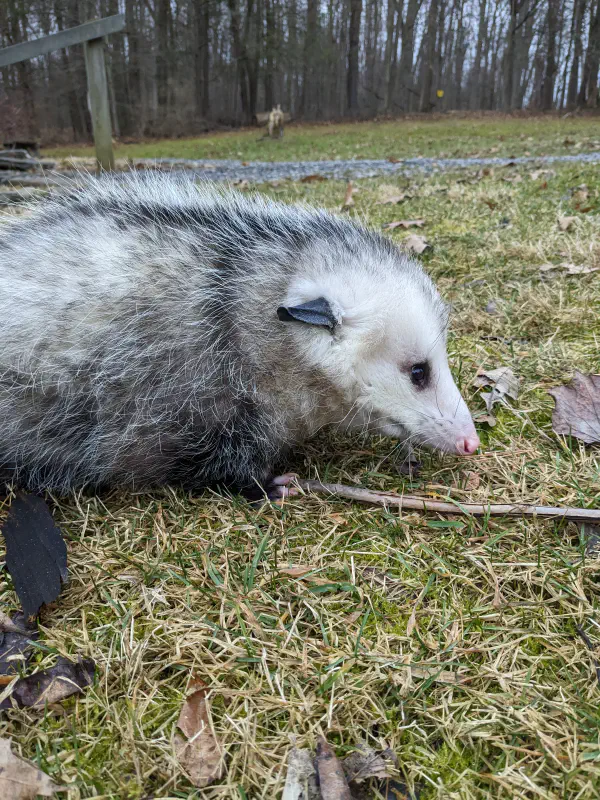Didelphis virginiana
Table of Contents

Scientific Classification
| Kingdom: Animalia |
| Phylum: Chordata |
| Class: Mammalia |
| Order: Didelphimorphia |
| Family: Didelphidae |
| Genus: Didelphis |
| Species: Didelphis virginiana |
Conservation Status
Identifying Features
Virginia Opossums’ fur is typically grayish, but it may range from a reddish, brownish or even blackish hue and the fur on their faces tends to be lighter than the rest of their body; it is typically pale grayish-white. They are robust marsupials, with short legs and thick bodies. They also have large delicate ears and long prehensile tails. Their dark feet are also specialized for climbing, including an opposable hallux (First Toe). Adult male Virginia Opossum’s tend to be larger than adult females.
Habitat & Range
Virginia Opossums are found from Costa Rica to Southern Ontario, Canada. In the United States, they are typically found east of the Rocky Mountains and along the west coast; they are restricted by temperature and snow depth. Their range continues to expand.
Virginia Opossums may live in woodlands and thickets but they are very often found within human altered areas. They typically prefer areas near a water source, such as a stream or swamp but have been extremely successful due to their ability to thrive in urban areas; this is assisted by their small body size, nocturnal habits and high reproductive output. Virginia Opossums nest in brush piles, hollow trees and drainage areas.
Behavior
Virginia Opossums are nocturnal, awake mostly at night, and counter to common belief they are mostly terrestrial, living on the ground. They are very adept climbers and may den up in trees. During their active time, dusk until dawn, males will travel greater distances in search of food and mates. Females will show greater variation in their movements by climbing or burrowing in a smaller area. Virginia Opossums may use buildings, hollow trees or abandoned burrows. They fill their den with substrate including dry leaves or shredded paper. Virginia Opossums change denning sites very often and only remain in a single den for long periods while weaning young.
Virginia Opossums are actually a neotropical species and have been able to spread so far north due to human altered environments and behavioral modification and metabolism of fat stores. Human architecture allows for hiding and denning sites that protect better from the cold and while they do not hibernate they reduce their activity during very cold temperatures. Due to their lack of fur on their ears and tails, northern populations of Virginia Opossums are prone to frostbite on those appendages.
Life Cycle
Virginia Opossums become sexually mature around 6 months for females and 8 months for males, but both typically begin breeding around 10 months. Male Virginia opossums possess a sexually dimorphic scent gland on their chest, which emits a musky odor and stains their fur; this is most commonly observed near the onset of the breeding season. Males also vie for reproductive females and Virginia Opossums engage in a polygynous mating system. Mating behavior is basically the only social behavior Virginia Opossums display, and after mating females return to being aggressively solitary.
In populations found at 44° N latitude, the breeding season lasts from February to September, whereas at 30°N latitude, the breeding season typically lasts from January to August. In northern regions, Virginia opossums average only one litter per year, in warmer climates the number of litters may increase to 3 per year. Being Marsupials they have a very short gestation period of only 12 to 13 days. Virginia Opossums, and all Marsupials, are altricial. Altricial means that an animal’s young is born underdeveloped and requires assistance from their parent/s until they are able to care for themselves.
When born Virginia Opossums are “honey bee sized,” about 14 mm long and 0.13 to 0.20 grams. While born very underdeveloped, babies do have very strong front legs. They are also born in groups of 4 to 25, though females only have 13 mammae some of which may be nonfunctional. Many baby Virginia Opossums do not survive making it to the pouch of their mother. And while mother Virginia Opossums tend to average 8 pouch young per litter, they can only have as many young as they have functional mammae. This is because each young Opossum will spend 50 to 70 days attached to a mammae.
The young begin eating solid food at around 85 days old and are fully weaned between 93 to 105 days old. After this period they are fully independent, though some young will remain in the weaning den with their mother until 120 days. Once independent only about 60% of Virginia Opossums will survive.
Featured image by Katie Bagnall-Newman


